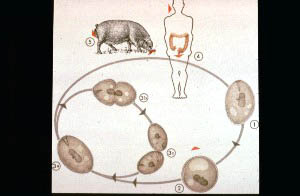

Balantidium coli - life cycle
- 1. Trophozoite in gut
- 2. Cyst form passed out with faeces
- 3a Trophozoite emerges from cyst in gut
- 3b Multiplication by binary fission
- 3c Sexual reproduction by conjugation between mating types
- 4 & 5 Humans and pigs become infected by ingesting cysts which develop into trophozoites in the gut and eventually give rise to a new generation of cysts that pass out with the faeces.
Individual trophozoites also gives rise to the cyst form which is passed out with the faeces and is the infective form for other hosts. The cyst form has reduced morphology and is covered by a thick wall which enables it to survive for considerable periods outside the host. Animals become infected by ingesting the cysts which give rise to trophozoite forms in the gut.
Humans can become infected with B.coli by ingesting material that has become contaminated with infected pig faeces.
See also